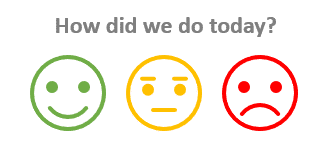Listening to your customers allows you to collect information to assess the experience you’re delivering – what’s working and what’s not working. It enables you to understand their goals and what they are looking for from your business. Even more importantly, you can use the voice of your customers as a continually evolving guide for many of the changes your business makes.
But wait…I’m busy. How can my company start?
Most businesses don’t have the size or scale to go out and hire a team of researchers and specialists to build out your CX function. It’s important to realize that it’s okay to start small. Have some conversations. Take some realistic steps. And start to see where the voice of your customer takes your business.
With that, here are four ways to start listening to the voice of your customer:
Idea #1: Ask your people who are on the front-lines
You may immediately say “But my employees aren’t my customers!” This is true. But in many cases, employees – especially those on the front-lines – have an expanded perspective on the customer experience you deliver. Employees who deal with many customers in a single day will have greater insight into your collective customer experience across their hundreds of interactions. A single customer may interact with your business through your website, but your front-line employees know all that transpires behind the scenes to deliver that experience. And employees may be working to compensate for inefficient processes in areas that could easily be improved.
When things such as technology or wait times or inefficient processes are frustrating to employees, it will most certainly negatively impact your customer experience. Soliciting regular feedback and input from your employees could help identify challenges before they reach the customer.
Asking employees for feedback about the customer experience comes with an added benefit: Increased buy-in and engagement from team members. When employees feel valued and respected by the company they work for, they tend to feel happier, which can also contribute to an overall customer experience. (Hint: we’ll talk more about this in our next article.)
What to do next:
- Ask employees to share feedback from customers and their own perspective of the customer experience.
- Ask employees to share their ideas about how to improve the customer experience going forward.
Idea #2: Conduct micro-surveys
Micro-surveys are short, targeted survey questions to customers that are usually executed on your website, over email, or within an app. They enable fast customer feedback and happen within the moment to help capture customer sentiment immediately. Unlike a product or company review, the benefit of getting feedback in real-time is that you gain insight into the customer mood or feeling at the time of engagement. Even better: Many micro-survey companies offer subscriptions that are less than $50 a month. That’s a lot of insight for very little money!
One example of a micro-survey
Micro-surveys can be as simple as a single question, such as “How was your experience today?” with a range of emoji faces the customer can choose from to answer.

The benefits of micro-surveys are:
- Get real-time reactions
- Quick and non-intrusive to the customer
- Customers feel valued and that their opinion is important
- Customers are likely to respond, especially with anonymous response options
- You can gather immediate results – make sure you build a process to immediately act upon negative feedback!
What to do next:
- Integrate a micro-survey right on your website, payment portal, email, or within an app. There are a variety of tools in the market, many are also budget friendly.





